Building A Framework For Markets In The Year Of The Rona
Since the world shut down due to the corona virus, most economic data has ceased to matter for the last two months, at least in the normal sense. I mean we know everything looks like trash from PMI data to housing data to anything. Thankfully there is still a way to look ahead a few months for most of the world and build out a probable range of outcomes. But first a quick re-cap.
-December 31st 2019 according to the WHO on December 31st 2019: China reports a cluster of cases of pneumonia in Wuhan.
-Jan 11th China reports first death.
-Jan 20th at least 5 other countries have confirmed cases.
-Jan 23rd Wuhan a city of 11 million people was cut off from the rest of China.
-Jan 24th several countries start to implement travel bans from China.
-Jan 30th the WHO declared it a global health emergency.
-Jan 31st supposedly the death toll at this point has hit 213…the next day it hits 259.
-Feb 7th the China whistleblower Doctor Li Wenliang dies after contracting the virus.
-Feb 12th the first big event is cancelled as Mobile World Congress decides it is not worth the risk.
Things start to go really fast now-By mid-February borders are closing and incoming flights from China are being shut down all over the place. Asian countries who have had to deal with other disease outbreaks over the last 20 years are the first to shut down and take precautionary measures and by the end of February the rest of the world is starting to get the message that things are going from bad to worse very quickly.
-Feb 19th the SP500 reaches an intraday high of 3393.52.
-Feb 20th and 21st it starts to sell off a little bit as some of the shutdowns are looking more and more serious. We, and by we I mean professional investors, have known of this thing since at least mid January and yet it is late February before we start to think “wait if China shut down a few cities with the population of Los Angeles and half of Asia has shut down maybe we should take this seriously.” But hey better late than never. BTW there is a lot wrapped up in the last few sentences but that is for a future post. Anyways we close that Friday the 21st at 3337.75.
-Feb 21st while updating some models I am chatting on Twitter with a buddy who runs a long/short fund and the flu comes up and we talk about how it finally seems to be hitting the mainstream news flow.
-Feb 24th the selloff really gets going. Sadly my account is not loaded up on way out of the money puts 🙂
-March 11th is the day that the west got their big wake up call that this was it, this was the big one. The Utah Jazz NBA team are having a great season and are in Oklahoma City to play the Thunder. This game matters because the Jazz are only one game ahead of the Thunder in the western conference and it is getting really close to the post-season (Can you tell I am a Jazz fan? I was watching all of this in real time). Anyways about 3 minutes before tip-off the referees are taken off court for a discussion, the teams get called back to their locker rooms, and then about 10 minutes later the game is called off. Rudy Gobert, the best center in the league, had some flu symptoms and they tested him for the virus and it came back positive. A little while longer Adam Silver the commissioner of the NBA turns off the NBA. Games already in session that night finish but then the league ceases to play.
-Over the next two weeks EVERYTHING starts to cancel. Sports cancel their seasons, conferences cancel, even Coachella cancels, etc. It feels surreal but the world now knows about the virus.
-March 15th Puerto Rico issues the first stay at home order in the United States.
-March 17th France shuts down the country. The EU barred almost all outside travel.
-March 20th New Yorks Governor Cuomo shuts down non-essential businesses.
-March 21st Hawaii orders a mandatory 14-day quarantine for any incoming visitors.
-March 23rd the UK is shut down.
-March 24th India is shut down.
-March 26th the US leads the world in confirmed cases.
-April 2nd over one million cases are confirmed worldwide.
-At this point some Asian countries are looking at cautious re-openings as many have done a good job of testing, tracing, and isolating or TTI. More on this in a minute.
As I write this the United States has now lost 95,823 people to the virus in a little over three months. We are losing around 2,000 people on a “normal” day now. Our curve has flattened but it is going down very slowly. In fact if you back out the New York state data the curve is still headed higher albeit at a relatively slow rate.
Over the past week we have seen several states start to open. Thankfully they are doing it in phases but still this is worth being concerned about. Yes, we need to reopen the economy but if we get a big enough spike in cases then presumably we would have to shut things down again. The President has said he is not closing the country down again…but it is up to the states and in an election year everyone on both sides of the aisle will be flexing at will. If/when that happens things could get really bad. As it is we already seem to be getting “used to” losing about 2,000 people a day. But that is a different conversation so let’s get back to the economy.
Wait you ask “where in any of this have we been talking about the economy?” well the entire thing really. By looking at what little history there is and taking the outside view by looking at what has happened in other countries we can actually construct a benchmark of sorts to see where the US, or any country really, comes out on the other end of all this.
China has re-opened but no one trusts their data or really anything they say. This is sad but basically true. Lucky for us the rest of Asia takes all the unique flu outbreaks seriously and acted earlier than the west by weeks and months. So what did they do, what did they do differently, how are their cases, and then how is their economic data looking? These are all questions we will look at.
Probably the best countries in terms of cases and deaths are Taiwan and Hong Kong (yeah I know HK is not its own country and right now has other issues but that is a different convo). Taiwan did not shut down its country and has still only had seven deaths. Hong Kong also did not shut down its borders and has only had four deaths. What have they done that is so effective at stopping the rona?
Well as we mentioned they are in Asia and have been hit by previous virus strains such as SARS back in 2003. So they already had good procedure in place, personal protective equipment PPE, and both a government and populace that for the most part understands how these things usually work.
While there are a few primary elements to their containment strategies the reality is that Taiwan for example had a 124 point plan. They had a LOT of steps in place to try and manage through a virus crisis. With all that said they have been relentless at what appears to be the winning strategy which is to first close their borders and then Test, Trace, and Isolate or TTI.
Most of the developed world had some testing capabilities but some did not have enough of it quickly enough, fewer countries have good tracing in place, and even fewer practice any official isolation. Part of the failure in following strict TTI protocols is due to privacy laws, but a large part is also due to lack of training and preparation.
Testing is simple enough. Ideally if someone shows even one symptom there is enough testing capacity in place for them to get tested. If they test positive then there should be a strong tracing effort. Here you want them to go through a solid interview looking for anyone and anything they have had contact with in X amount of days. Interview, look at their mobile data, etc. Then you take the person who tested positive and instead of saying “go home and self isolate” you say “come with me we have a room for you.” By doing this they can’t inadvertently pass the virus on to a family member, a neighbor, food delivery person, etc. If a country follows these steps religiously then it seem as though they can really contain the virus. The less they adhere to these steps the more room there is for spread.
On the population side what we have also seen in most of Asia, and Taiwan and Hong Kong count here, is that almost everyone wears a mask while around other people, they wash hands like peoples lives depend on it (they do), and then have temperature checks all over the place. Some places have sensors at the entrance to buildings while others just do it at certain places. But the point is that they check it and if you have a high temp you get tested….and if positive you get traced….and then you are isolated until you recover.
TTI, masks, hand washing, and temperature checks seem to really keep the virus at bay. And you don’t have to fully shut down your economy.
In some countries, like the United States, a few of these procedures fall into a legal gray area and a few of them just caught us flat footed. We still do not have enough PPE gear for first responders so we definitely don’t have it for the regular population. And while we were initially way behind on testing we have made some big steps towards getting caught up. It would be nice if there was more testing available and that it was easier to get tested, but the trend has been strong towards more and more states adopting free testing models requiring only one symptom. But we still do very little tracing and with rare exceptions we do not isolate cases who test positive. Instead, assuming they don’t need hospitalization, we allow them to go home and self isolate. This allows for leakage where one or two more people end up getting it and then before they show symptoms they spread it even more. But forced isolation is a legal issue that most states have chosen not to try out.
Another part of isolation that many countries have had success with is for anyone coming into the country to be quarantined for 14 days before they are able to go around the country. In the US we do not quarantine people coming in, we do not test at the airports, and we do not require the airlines to do the spacing that they claimed they would do. Remember the “we will leave the middle rows empty” thing? Yeah for the most part it is not happening as more and more planes have been taken offline due to very low passenger levels.
Here are a few charts showing how well some countries flattened and even seem to have killed their curve and then a few that have not done so well.
First up are three of the Asian countries that have done exceptionally well combating the virus. South Korea has been diligent in attacking each breakout but have definitely had more than Taiwan or Thailand but far less than most western countries in absolute or per capita.
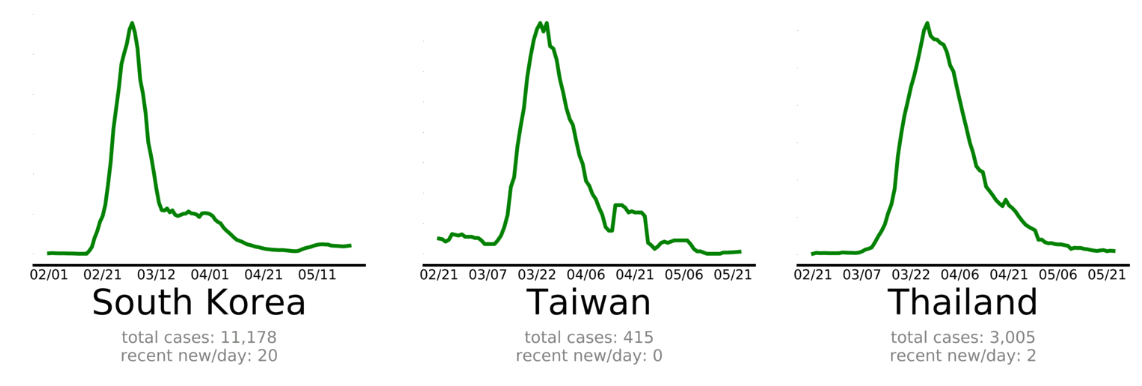
In the next panel we have countries that have done well and yet they are a bit different. New Zealand for instance has squashed the virus but they are a remote island with a relatively low population. They can truly close off any incoming traffic. Monaco is not an island but at 499 acres is smaller than most golf courses. So while these countries have done quite well they are also not very good comparisons.

Looking at countries that have not done so well we see everything from hockey sticks that would make a venture capitalist proud like Peru, South Africa, or Sudan and then countries that seem to be getting it under control as their curves while still high, are at least bending like the United States, UK, and Sweden.
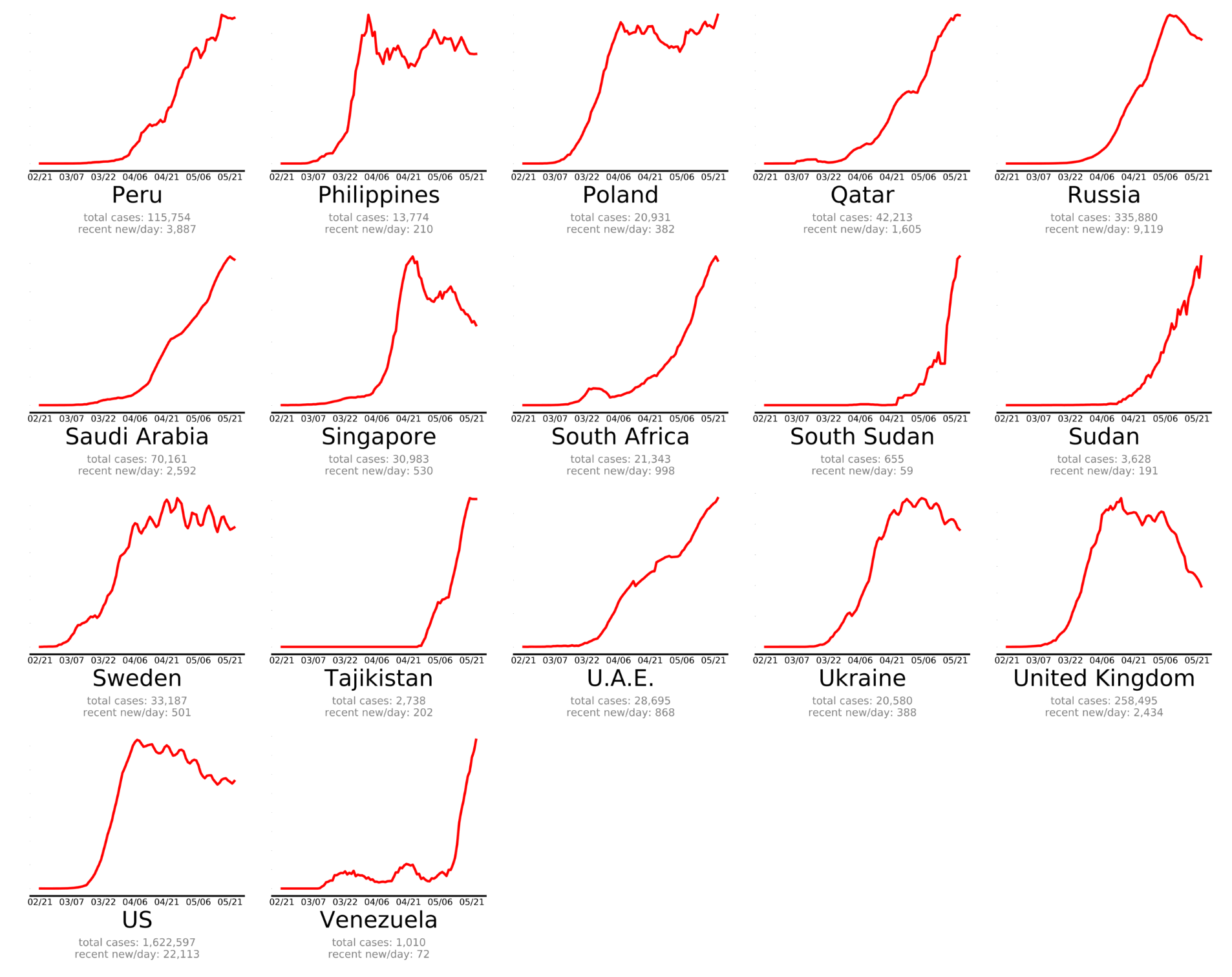
One thing worth noting is that Sweden has gotten a LOT of press for going the “herd immunity” route despite not knowing how well the antibodies post-Covid even function. Big gamble but more on that in a moment.
So how do we take all this and try and look into the future or at least build the beginnings of a probability distribution for what will happen to different countries going forward? We start with the countries who had breakouts first and work from there. China had it first, then the rest of Asia, then parts of Europe like Italy, and then the United States. With a lead time of weeks to months we are just starting to see enough leading data to figure out some likely paths. By then looking at what these countries did to mitigate the spread of the virus we can see if a country is more or less likely to do as well.
First up of course is China. Once the breakout in Wuhan got going China shut down both Wuhan (population 11.08m) and Hubei Province (population 58.5m). As things have progressed they have opened and shut down these as well as other areas. We are going to look at the PMI data here as it is one of the more reliable data series out of China…but it still comes out of China. So how have they done? As you can see in the chart below it tanked and then rebounded to above the 50 level only to start falling off again. Maybe, anything is possible, other countries can follow this path.
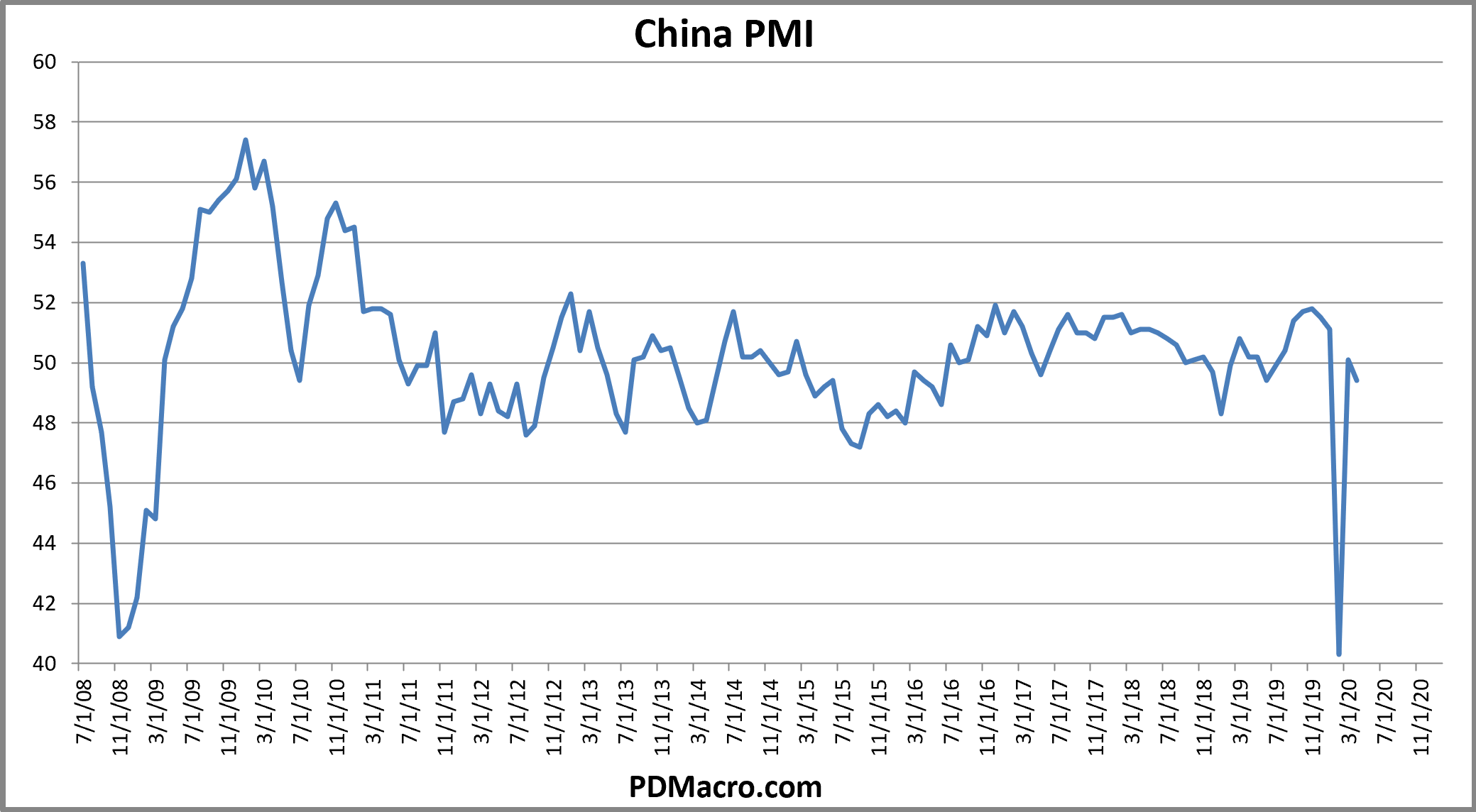
Why the sarcasm? It should become apparent in the next chart. Here is the chart of the Taiwan PMI. It has fallen and so far has not seen a rebound. The data we get on the 1st will be interesting because from most of the data we have seen so far Taiwan has slowed considerably despite NOT shutting down its economy.
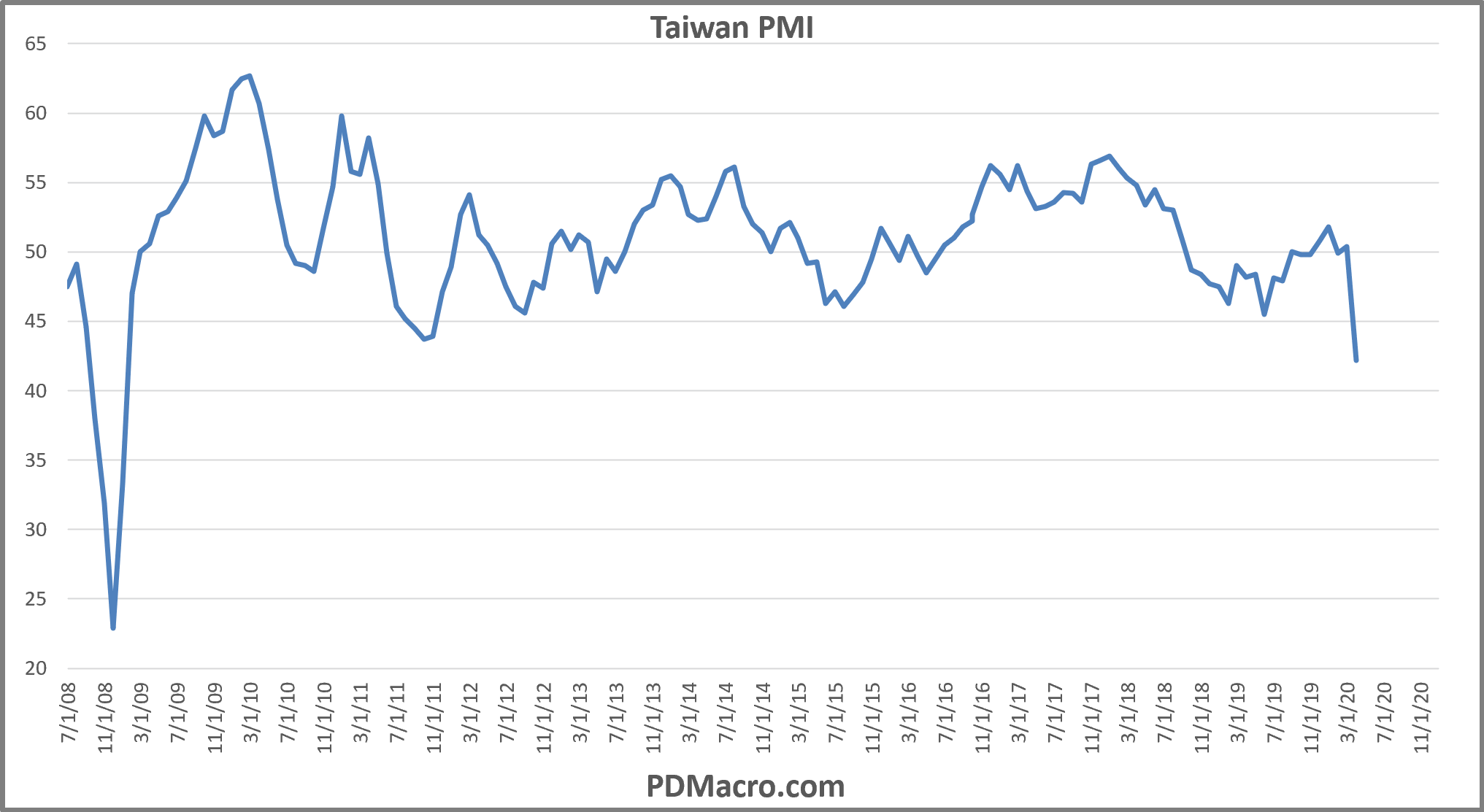
Next up is South Korea. It too has fallen precipitously. It did more shutting down than Taiwan but both of their charts look the same.
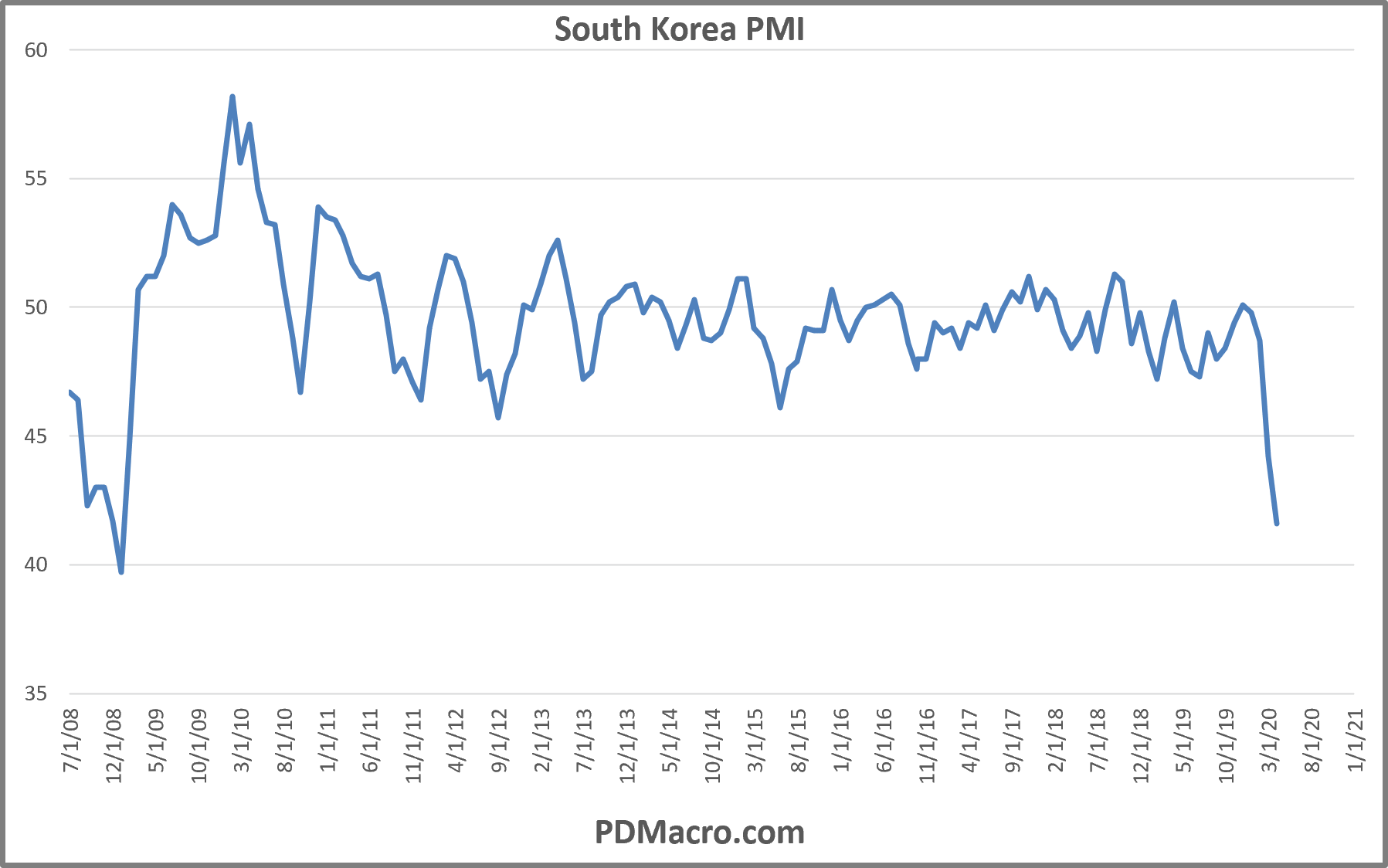
What about Hong Kong? They have done a great job with the virus and have only had a few deaths and have not had to shut down their economy and yet….their PMI dropped like a rock as well, and the drop was followed by a very weak rebound. Of course with all the protests against China for not honoring the agreement this economy has been relatively weak for a while now.
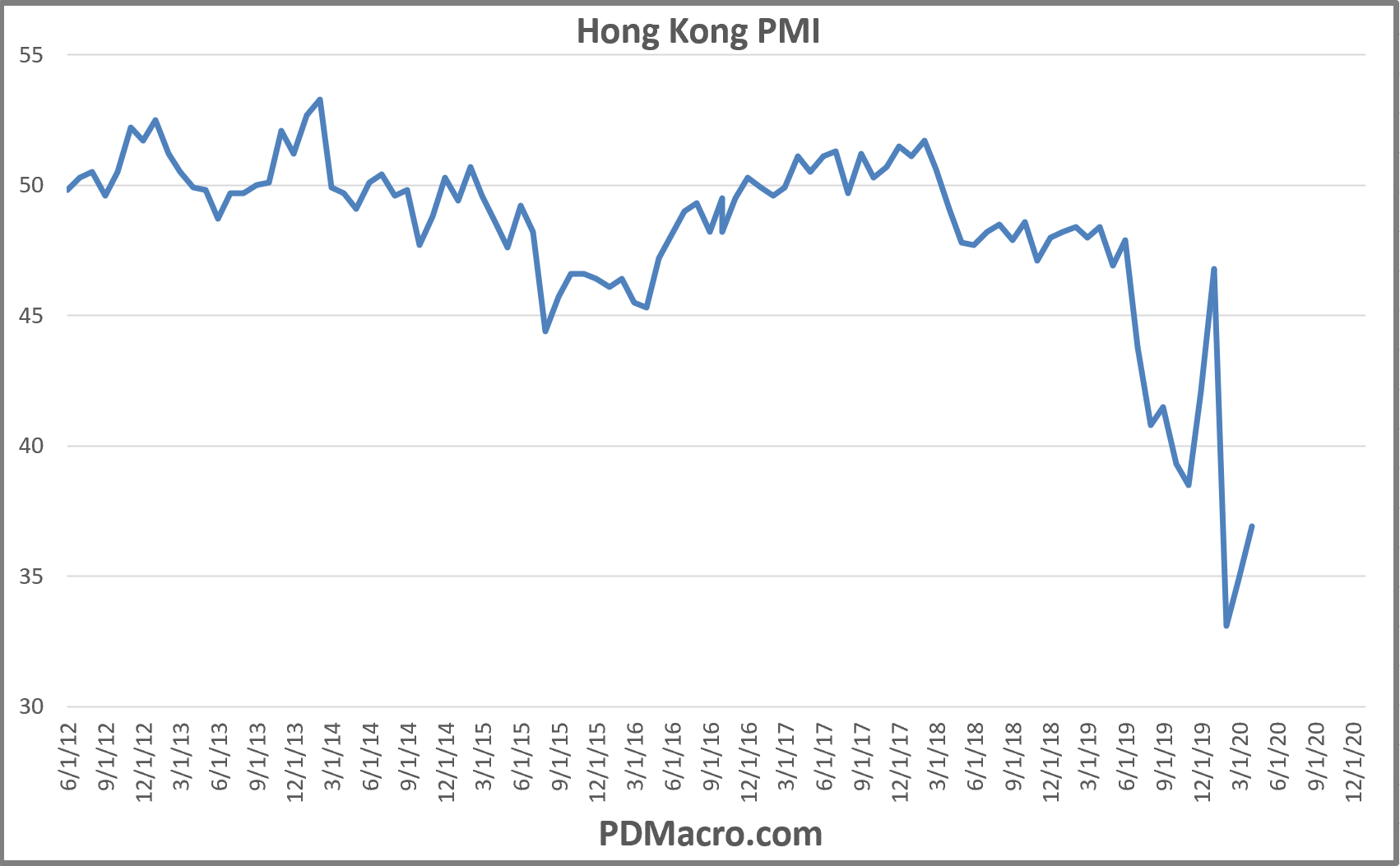
So we have seen how Asian countries that have had very low death rates, very low infection rates, and have NOT closed down their economies have done. What about a western country that has stayed open? Surely a place like Sweden has done better than its neighbors right? Nope, not at all. So far they have a far higher death rate than Norway and also have a weaker economy. This should be sounding off alarm bells.
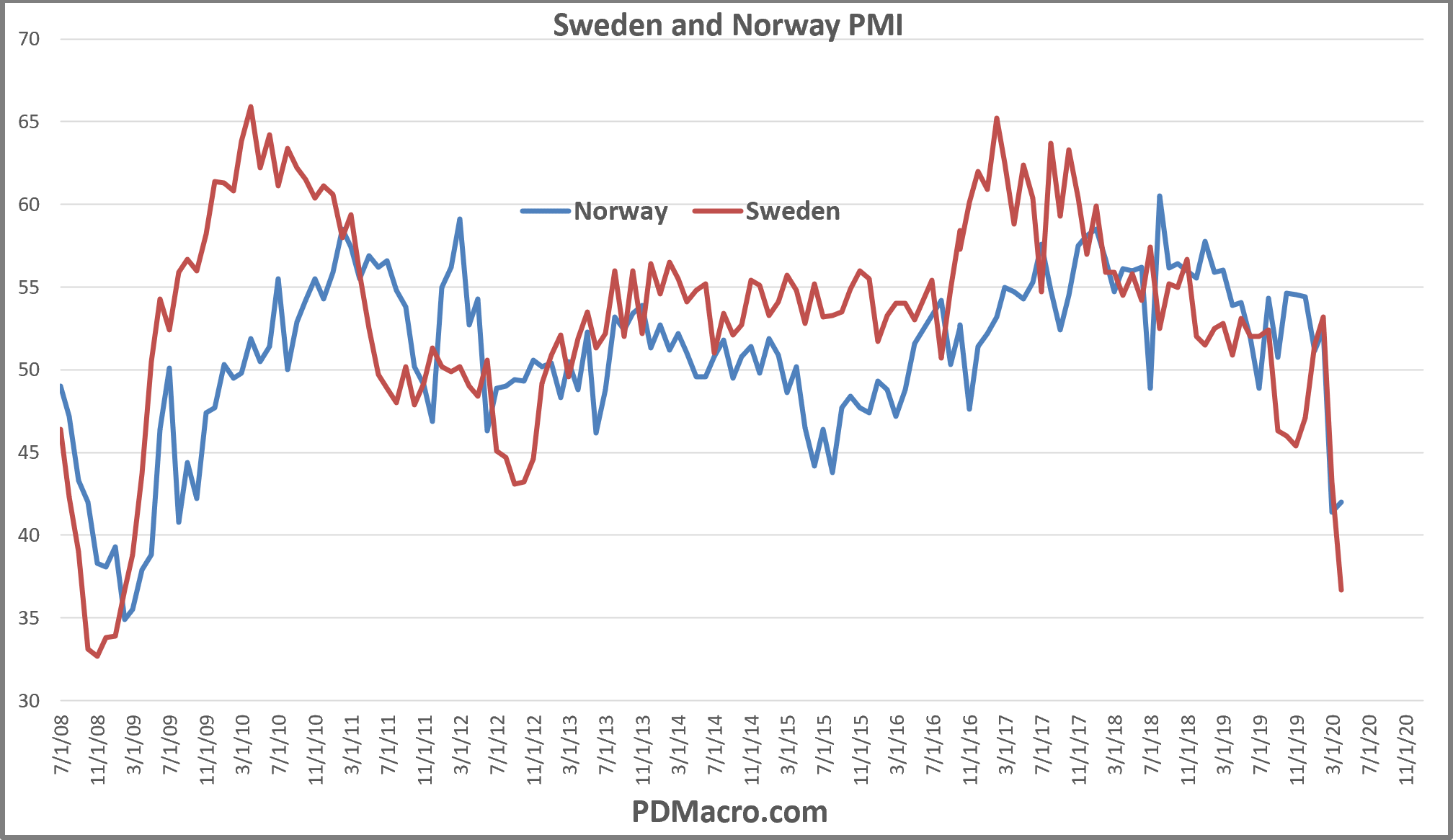
If a western country like Sweden is doing worse than its neighbors while staying open at the same time as some Asian countries like Taiwan are slowing despite almost no deaths then it begs several questions moving forward. Are people “that” scared? How much does shutting down or staying open even matter if your neighbors are doing the opposite?
Depending on the country you are looking at you will want to ask those questions to a greater or lesser degree. The United States for instance is far less dependent on other countries than a place like Taiwan. Canada needs the United States far more than they need the rest of the world. The same can not be said for places in Europe or Asia who depend on trade with their many neighbors to a far greater extent. So trade partners would seem to matter a lot.
As we get more country level data over the coming weeks and months we will of course be tracking it to see how the economies are doing. By combining the econ data with the efficacy of each countries and its neighbors virus protocols we expect to get a slightly less clouded view of what will happen going forward. This matters right now but if we get the expected 2nd and 3rd waves it will matter going forward. We will have better treatments in the coming months and with some luck we will have vaccine in the next year or two, but until then this thing will be with us.
The above is obviously just a starting point. Most developed economies have already hit their “economic” bottoms as world trade came to a halt and most of the world stayed home. We are closely monitoring the monthly data like the PMI’s but also higher frequency data like airline passengers, gasoline usage and miles driven, electricity usage, cell phone travel, and mobility indices which are all ticking higher. This is all a starting point. Next you need to adjust for things like what trade deals survive, what trade deals die, are we in a new cold/semi-hot war, etc? But that is for a future post.
Happy Trading and Be Safe,
P.S. If you liked this then take a free two week trial of our service. If you have any questions send me an email or find me over at Twitter @DavidTaggart
